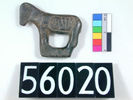Donkeys and Mules
The donkey (Equius asinus) was the most important load carrier in Ancient Egypt, attested already in the Maadi Period. It was also used for ploughing the seed into the ground. Donkeys were also used to carry people. An Old Kingdom tomb-chapel relief shows an official sitting on a wooden box which was hung between two donkeys. A biography of the Sixth Dynasty reports that 300 donkeys were used as carrier through the desert.
Hinny is the offspring of a male horse and female donkey. The mule is the offspring of female horse and male donkey: mules are bigger and stronger than donkeys. They have many of the same characteristics as the donkey - long ears, a tufted tail, slender legs, small hooves, and a loud bray—but they resemble the horse more in size and strength. The identification of mule bones is very problematic. The shape and size of the bones are in a middle position between horses and donkeys. Mules seem to appear sporadically in depictions, showing that they were used since the New Kingdom.
Donkeys and mules do not play an important part in Egyptian religious iconography, and they are not symbols of high status, and therefore not so often depicted in art.
further reading:
